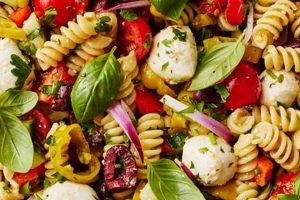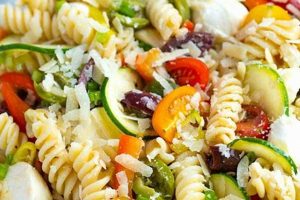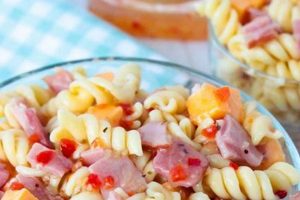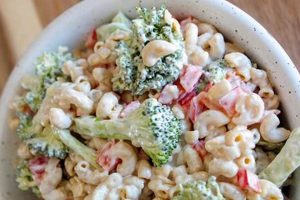Dishes centered around pasta enriched with high-protein ingredients offer a nutritious and satisfying meal option. These salads typically include pasta (often whole wheat or legume-based), a protein source such as beans, lentils, chickpeas, cheese, or lean meats, and a variety of vegetables. A flavorful dressing binds the ingredients together, creating a complete and balanced dish.
Such culinary creations are valuable for their nutritional density and versatility. They provide a good source of complex carbohydrates for sustained energy, along with essential protein for muscle building and repair. The inclusion of vegetables adds vital vitamins, minerals, and fiber. These salads can be adapted to various dietary preferences and needs, making them suitable for individuals seeking vegetarian, vegan, or gluten-free options. Historically, pasta salads have evolved from simple side dishes to main courses, reflecting changing culinary trends and nutritional awareness.
The following sections will delve into specific ingredient choices, preparation techniques, variations for different dietary needs, and tips for maximizing flavor and nutritional value.
Tips for Creating Exceptional High-Protein Pasta Salads
Optimizing ingredient selection and preparation methods elevates a basic pasta salad into a flavorful and nutritious meal. The following tips offer guidance for crafting exceptional dishes.
Tip 1: Prioritize Whole Grains and Legumes. Opting for whole wheat pasta or legume-based pasta increases fiber content, promoting digestive health and satiety. Lentils, chickpeas, and black beans further enhance the protein and fiber profile.
Tip 2: Diversify Protein Sources. Combining plant-based proteins with lean meats like grilled chicken or fish creates a complete protein source and adds depth of flavor. Cheese, such as feta or cubed mozzarella, offers another protein-rich option.
Tip 3: Maximize Vegetable Variety. Incorporating a colorful array of vegetables, such as bell peppers, cucumbers, tomatoes, and spinach, boosts the nutritional value and provides textural interest.
Tip 4: Craft a Flavorful Dressing. A well-balanced dressing ties the salad together. Vinaigrettes made with olive oil, lemon juice, or vinegar offer a light and tangy option. Creamy dressings can be made healthier by using Greek yogurt as a base.
Tip 5: Consider Pre-Cooking Pasta Strategically. Cooking pasta al dente and rinsing it under cold water prevents sticking and ensures a desirable texture in the final salad.
Tip 6: Enhance Flavor with Herbs and Spices. Fresh herbs, such as basil, parsley, or oregano, add vibrant flavor. Spices like cumin, paprika, or garlic powder further elevate the taste profile.
Tip 7: Chill Before Serving. Allowing the salad to chill in the refrigerator for at least 30 minutes allows the flavors to meld and creates a refreshing dish.
By following these guidelines, one can create a delicious and nutritious pasta salad that contributes to a balanced diet. These versatile dishes can be customized to individual preferences and dietary needs.
From ingredient selection to preparation methods, mindful choices yield optimal results. The following section will offer concluding remarks on the value and adaptability of protein-rich pasta salads.
1. High-Protein Ingredients
High-protein ingredients form the foundation of a successful protein pasta salad recipe, contributing significantly to its nutritional value and satiety factor. Understanding the role of different protein sources is crucial for creating a balanced and flavorful dish.
- Legumes
Legumes, such as chickpeas, lentils, and black beans, offer a plant-based protein source rich in fiber and essential nutrients. Their versatility allows for seamless integration into pasta salads, adding both texture and nutritional density. Chickpeas, for instance, provide a robust texture and pair well with Mediterranean flavors, while lentils offer a milder flavor and readily absorb the flavors of the dressing.
- Lean Meats
Grilled chicken, fish (such as tuna or salmon), or lean cuts of beef contribute substantial protein and diverse flavor profiles. Grilled chicken offers a classic, versatile option, while flaked tuna or salmon introduces omega-3 fatty acids. Incorporating lean meats allows for customization based on dietary preferences and desired flavor profiles.
- Cheese
Cheese varieties like feta, mozzarella, or Parmesan provide a dairy-based protein source and enhance the richness of the salad. Feta crumbles offer a salty, tangy element, while cubed mozzarella contributes a creamy texture. Parmesan shavings add a sharp, savory note. The choice of cheese influences the overall flavor profile.
- Tofu and Tempeh
Tofu and tempeh, derived from soybeans, offer plant-based protein alternatives with varying textures and flavor absorption capabilities. Tofu, particularly when marinated and grilled, adds a firm, savory component. Tempeh, with its nutty flavor and dense texture, provides a hearty element to the salad.
The strategic selection and combination of these high-protein ingredients contribute significantly to the overall nutritional value and culinary appeal of a protein pasta salad. Careful consideration of flavor profiles, textures, and dietary preferences allows for the creation of a balanced and satisfying dish.
2. Varied Vegetables
The incorporation of varied vegetables is integral to a successful protein pasta salad recipe, contributing significantly to nutritional value, flavor complexity, and textural appeal. Vegetables offer a wealth of vitamins, minerals, and fiber, enhancing the nutritional profile of the dish beyond protein and carbohydrates. Furthermore, the diverse flavors and textures of different vegetables create a more engaging and satisfying culinary experience. The inclusion of crunchy vegetables like bell peppers or cucumbers contrasts with the softness of cooked pasta, while the sweetness of cherry tomatoes complements the savory notes of other ingredients.
Consider a pasta salad featuring grilled chicken, chickpeas, and whole wheat pasta. Adding chopped bell peppers (red, yellow, and orange) introduces not only vibrant color but also vitamin C and antioxidants. Including cucumber adds a refreshing crunch and hydration, while halved cherry tomatoes contribute sweetness and lycopene. Spinach provides folate and a mild, earthy flavor. This combination of vegetables creates a balanced nutritional profile and a multi-faceted sensory experience. Alternatively, a Mediterranean-inspired pasta salad might include Kalamata olives, artichoke hearts, and sun-dried tomatoes, contributing distinct flavors and textures characteristic of the region.
In conclusion, the inclusion of varied vegetables in a protein pasta salad recipe is not merely an aesthetic choice but a crucial step toward creating a nutritionally balanced and flavorful dish. Strategic selection of vegetables based on their individual characteristicscolor, texture, flavor, and nutrient contentenhances the overall appeal and health benefits of the salad. This understanding allows for the creation of diverse and satisfying meals suitable for various dietary preferences and occasions.
3. Flavorful Dressings
Flavorful dressings are essential to a successful protein pasta salad recipe. They serve not merely as a coating but as a unifying element, binding the diverse ingredients and creating a cohesive culinary experience. The dressing’s flavor profile significantly influences the overall perception of the dish, balancing and enhancing the individual flavors of the pasta, protein, and vegetables. A bland or poorly chosen dressing can render a salad unappetizing, while a well-crafted dressing elevates the dish to a new level of culinary enjoyment.
Consider a pasta salad composed of grilled chicken, roasted vegetables, and whole wheat pasta. A simple vinaigrette made with olive oil, lemon juice, garlic, and oregano would complement the savory chicken and vegetables, creating a light and refreshing flavor profile. Alternatively, a creamy dressing based on Greek yogurt, dill, and lemon zest could highlight the flavors of a salmon and cucumber pasta salad. These examples illustrate how dressing choice directly impacts the final product. Furthermore, dressings contribute to the textural complexity of the salad. A light vinaigrette adds a subtle sheen and moisture, while a creamy dressing provides a richer, more substantial coating.
The practical significance of understanding the role of dressings lies in the ability to tailor them to specific ingredient combinations. A salad featuring robust flavors, like sun-dried tomatoes or olives, might benefit from a bolder dressing, perhaps incorporating balsamic vinegar or Dijon mustard. Conversely, a salad with delicate flavors, such as fresh herbs and light cheeses, requires a more subtle dressing to avoid overpowering the other ingredients. Careful consideration of flavor profiles and desired outcomes is key to creating a harmonious and delicious protein pasta salad. Ultimately, the dressing choice determines the overall character of the dish, influencing its palatability and the overall dining experience.
4. Pasta Choice (Whole Grain)
Pasta selection significantly influences the nutritional value and culinary outcome of a protein pasta salad recipe. While refined pasta offers a familiar texture and flavor, whole grain pasta provides substantial health benefits and unique culinary characteristics. Understanding these distinctions is crucial for creating a truly nutritious and satisfying dish.
- Nutritional Advantages
Whole grain pasta retains the bran and germ of the wheat kernel, providing a rich source of fiber, vitamins, and minerals often absent in refined pasta. This higher fiber content promotes digestive health, aids in blood sugar regulation, and contributes to feelings of fullness, aligning with the health-conscious goals often associated with protein-rich meals. The inclusion of these nutrients further enhances the overall nutritional density of the pasta salad.
- Culinary Impact
Whole grain pasta possesses a slightly nuttier flavor and chewier texture compared to refined pasta. This distinct character can complement the flavors and textures of other salad components, such as robust vegetables or hearty proteins. For instance, the earthiness of whole wheat pasta pairs well with roasted vegetables and grilled chicken, creating a harmonious balance of flavors.
- Glycemic Index Considerations
Whole grain pasta typically has a lower glycemic index than refined pasta, meaning it causes a slower and more gradual rise in blood sugar levels. This characteristic is particularly beneficial for individuals managing blood sugar or seeking sustained energy release, further supporting the health-conscious nature of protein pasta salads.
- Versatility and Adaptability
Whole grain pasta comes in various shapes and sizes, offering versatility in recipe development. From rotini and penne to fusilli and farfalle, different shapes can be chosen based on aesthetic preferences and how well they hold the dressing and other ingredients. This adaptability allows for customization and creative exploration within the protein pasta salad paradigm.
Therefore, opting for whole grain pasta in a protein pasta salad recipe represents a nutritionally and culinarily advantageous choice. It enhances the dish’s fiber content, vitamin and mineral profile, and contributes distinct textural and flavor elements. This conscious ingredient selection aligns with the broader health-conscious objectives often associated with incorporating protein-rich meals into one’s diet, ultimately contributing to a more wholesome and satisfying culinary experience.
5. Proper Cooking Techniques
Proper cooking techniques are essential for achieving a desirable texture and optimizing the flavor contribution of pasta within a protein pasta salad recipe. Overcooked pasta becomes mushy and absorbs less dressing, resulting in a less palatable and aesthetically unappealing salad. Undercooked pasta, conversely, presents a tough, unyielding texture that detracts from the overall sensory experience. The ideal texture is al dente, meaning “to the tooth” in Italian, indicating a firm yet tender consistency. Achieving this requires careful attention to cooking time and proper handling of the pasta.
The impact of cooking techniques extends beyond texture. Overcooked pasta releases excess starch, which can make the salad sticky and heavy. This negatively affects the distribution of the dressing and the overall balance of flavors. Properly cooked pasta, however, maintains its structural integrity, allowing it to absorb the dressing evenly and contribute its subtle flavor to the dish. For example, if one aims to create a Mediterranean-inspired pasta salad with a light lemon vinaigrette, overcooked pasta would absorb less of the dressing, diminishing the bright, citrusy notes. Conversely, al dente pasta would hold the dressing well, allowing the flavors to meld harmoniously. Furthermore, the cooling process also influences the final texture. Rinsing the cooked pasta under cold water stops the cooking process and removes excess starch, preventing stickiness and maintaining the desired firmness.
Mastery of proper pasta cooking techniques is therefore crucial for achieving the desired culinary outcome. This understanding translates directly to a more enjoyable and aesthetically pleasing protein pasta salad. Attention to detail in this seemingly simple step significantly influences the overall success of the recipe, impacting texture, flavor absorption, and the harmonious integration of all ingredients. A properly cooked pasta provides a neutral yet subtly flavorful canvas upon which the other components of the salad can shine, maximizing the culinary potential of the dish.
6. Complementary Herbs and Spices
The strategic use of herbs and spices significantly elevates a protein pasta salad recipe from simple sustenance to a flavorful culinary creation. These aromatic additions contribute depth, complexity, and balance, transforming the perceived taste and aroma of the dish. Their impact extends beyond mere flavor enhancement; herbs and spices can also complement and enhance the inherent flavors of the other ingredients, creating a synergistic culinary experience. Fresh herbs, such as basil, parsley, dill, and mint, introduce vibrant, herbaceous notes, while dried spices like oregano, cumin, paprika, and garlic powder offer concentrated, earthy undertones. The selection and combination of these elements should reflect the overall flavor profile desired for the salad.
Consider a Mediterranean-inspired protein pasta salad featuring chickpeas, feta cheese, and a lemon vinaigrette. The addition of fresh dill and oregano complements the briny feta and bright citrus, creating a cohesive and refreshing flavor profile. Conversely, a Southwestern-inspired pasta salad with black beans, corn, and a lime dressing might benefit from the inclusion of cumin, chili powder, and cilantro, adding warmth and complexity. These examples demonstrate how specific herb and spice combinations can enhance and define the character of a dish. Furthermore, the form in which herbs and spices are incorporatedfreshly chopped, dried and ground, or even as whole seedsinfluences their impact on the final product. Fresh herbs offer a brighter, more delicate flavor, while dried spices provide a more concentrated and robust presence. Understanding these nuances allows for precise control over the final flavor profile.
In conclusion, the judicious use of complementary herbs and spices is an essential aspect of crafting a truly exceptional protein pasta salad. These ingredients contribute not only distinct flavors but also aromatic complexity, elevating the sensory experience of the dish. Careful consideration of flavor pairings and the interplay between fresh and dried herbs and spices allows for the creation of well-balanced and nuanced flavor profiles. This understanding empowers culinary exploration and transforms a basic protein pasta salad into a memorable culinary creation.
7. Thoughtful Preparation
Thoughtful preparation is crucial for maximizing the quality and enjoyment of a protein pasta salad recipe. It encompasses various considerations beyond simply combining ingredients, impacting the final dish’s flavor, texture, and overall appeal. Careful planning and execution elevate the culinary experience, ensuring a harmonious blend of flavors and textures.
- Ingredient Timing
Ingredient timing significantly influences the final outcome. Adding certain ingredients too early can lead to undesirable changes in texture or flavor. Delicate vegetables, such as spinach or herbs, should be added just before serving to prevent wilting or loss of vibrancy. Conversely, more robust vegetables, like bell peppers or onions, can be incorporated earlier. Similarly, allowing certain flavors to meld, such as marinating the protein or allowing the salad to chill before serving, enhances the overall taste and cohesion.
- Temperature Considerations
Temperature plays a crucial role in both food safety and maximizing enjoyment. Ensuring ingredients like cooked chicken or fish are thoroughly chilled before adding them to the salad prevents bacterial growth. Furthermore, serving the salad at the appropriate temperature enhances the sensory experience. A chilled pasta salad is refreshing on a warm day, while a room-temperature salad might be preferred during colder months. Attention to temperature preserves both the quality and safety of the dish.
- Presentation and Serving
Presentation elevates the dining experience, transforming a simple pasta salad into a visually appealing dish. Thoughtful plating, such as arranging the salad on a platter with garnishes or serving individual portions in attractive bowls, enhances the overall presentation. Attention to detail, such as ensuring an even distribution of ingredients and colors, makes the dish more appetizing. These aesthetic considerations contribute to a more enjoyable culinary experience.
- Storage and Preservation
Proper storage preserves the freshness and quality of leftover protein pasta salad. Storing the salad in an airtight container in the refrigerator prevents spoilage and maintains its flavor and texture. Understanding the shelf life of different ingredients and the overall salad is crucial for food safety and minimizing waste. Proper storage practices maximize the longevity and enjoyment of the dish beyond the initial serving.
These facets of thoughtful preparation demonstrate that creating a successful protein pasta salad extends beyond simply following a recipe. Careful consideration of ingredient timing, temperature, presentation, and storage elevates the dish from a basic meal to a carefully crafted culinary experience. Attention to these details ensures a flavorful, visually appealing, and safe-to-consume protein pasta salad that can be enjoyed to its fullest potential.
Frequently Asked Questions
This section addresses common inquiries regarding the creation and enjoyment of protein-rich pasta salads.
Question 1: What is the best way to prevent pasta salad from becoming soggy?
Sogginess often results from overcooked pasta or excessive dressing. Cooking pasta al dente and adding the dressing just before serving helps maintain the desired texture. Rinsing cooked pasta under cold water also minimizes stickiness.
Question 2: Can protein pasta salad be made ahead of time?
Advance preparation is possible, but certain precautions should be taken. Adding the dressing close to serving time prevents the salad from becoming soggy. Delicate ingredients like fresh herbs should also be added just before serving to maintain their vibrancy.
Question 3: How long can protein pasta salad be stored in the refrigerator?
Properly stored in an airtight container, pasta salad with protein typically lasts three to five days in the refrigerator. However, the shelf life may vary depending on the specific ingredients used. Spoilage signs should always be checked before consumption.
Question 4: What are the best protein sources for a vegetarian pasta salad?
Excellent vegetarian protein sources include legumes (chickpeas, lentils, black beans), cheese (feta, mozzarella), tofu, and tempeh. Combining different plant-based proteins ensures a complete amino acid profile.
Question 5: How can one reduce the calorie content of a protein pasta salad?
Calorie reduction can be achieved through several strategies. Using whole grain pasta, increasing the proportion of vegetables, opting for lean protein sources, and using a light vinaigrette dressing contribute to a lower-calorie dish.
Question 6: Are there gluten-free options for protein pasta salad?
Gluten-free pasta varieties, made from ingredients such as brown rice, quinoa, or lentils, provide suitable alternatives for individuals avoiding gluten. Ensuring other ingredients, such as dressings and sauces, are also gluten-free is essential.
Understanding these aspects allows for greater control over the quality and outcome of a protein pasta salad recipe. Careful consideration of ingredient choices, preparation methods, and storage practices contributes to a satisfying and nutritious meal.
This concludes the frequently asked questions section. The following sections will offer recipe variations and additional tips for optimizing flavor and nutrition.
Protein Pasta Salad Recipe
Exploration of protein pasta salad recipes reveals a versatile culinary landscape encompassing nutritional value, flavor complexity, and adaptability. Key elements highlighted include the strategic selection of high-protein ingredients, the incorporation of diverse vegetables, the crucial role of flavorful dressings, the advantages of whole grain pasta, the importance of proper cooking techniques, the transformative impact of herbs and spices, and the significance of thoughtful preparation. Each component contributes to the overall success of the dish, impacting not only its nutritional profile but also its sensory appeal and culinary potential.
Protein pasta salad recipes offer a canvas for culinary creativity and nutritional optimization. Potential for customization based on individual dietary needs and preferences positions these dishes as valuable additions to diverse meal plans. Further exploration of ingredient combinations, flavor profiles, and culinary techniques promises continued evolution and enjoyment within this culinary category.






